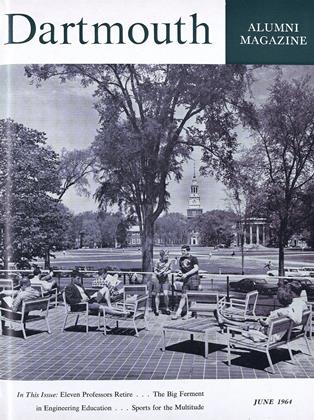Edited by David L. Larson '52. Boston:Houghton Mifflin Co., 1963. $2.75.
In the decade of the '50's the perplexities and frustrations of unaccustomed international involvement focussed for Americans on the mainland Chinese situation. In the '60's Cuba has become the principal object of American puzzlement and dismay over what seems an inexplicable discrepancy between our absolute national power and the achievement of international security. Strangely, not massive China but tiny and weak Cuba brought Soviet Russia and the United States to their sharpest confrontation of the Cold War, to a mutual "looking down the barrel" whose tense gravity has already receded from the memories of most persons.
But Castro's Cuba will not soon disappear as a subject of earnest civic concern as well as of partisan political polemics. David L. Larson, who is a member of the staff at Tufts University, has compiled a series of documents and constructed a chronology to inform serious discussion of the Cuba case with an absolutely indispensable underpining of factual knowledge. He has used care and wisdom in making his selection. The preface contains the modest disclaimer that the collection is not "definitive, largely because completeness is neither wholly possible [because of the classified nature of much documentary material] nor wholly necessary."
Mr. Larson is correct for the dangerous path of the crisis is indeed well traced by him from the publicly available sources. The story unfolds itself from an initial statement by President Kennedy on September 4, 1962, to the fateful television address by the late President on October 22, and through to the final notes to and from U Thant, Secretary General of the United Nations, which marked the official close of the incident.
The 60-page chronology included in the appendices is also most useful, especially for those persons who would at least begin to inform themselves concerning an island about which so many talk so loosely. Mr. Larson begins with an entry for November 6-16, 1686, and ends on January 8, 1963 - a skeletal but suggestive tracing of what has been justly called the Cuban tragedy.
Latin American scholarship needs many more good practitioners. Let us hope Mr. Larson continues an interest he has begun with humility, honesty, and immediate usefulness.
Professor of Government
 View Full Issue
View Full Issue
More From This Issue
-
 Feature
FeatureThe Big Ferment in Engineering Education
June 1964 By DAVID ALLISON, -
 Feature
FeatureA Teacher's Real Reward
June 1964 -
 Feature
FeatureSports for the Multitude
June 1964 By LARRY GEIGER '66 -
 Article
ArticleTHE UNDERGRADUATE CHAIR
June 1964 By DAVE BOLDT '63 -
 Class Notes
Class Notes1920
June 1964 By CHARLES F. MCGOUGHRAN, JHON S. MAYER -
 Class Notes
Class Notes1930
June 1964 By WALLACE BLAKEY, ARTHUR M. BROWNING
KALMAN H. SILVERT
Books
-
 Books
BooksHOW TO FLY.
APRIL 1930 By A. P. -
 Books
BooksCOME AS YOU ARE
January 1953 By CHURCHILL LATHROP -
 Books
BooksCORPORATE CONCENTRATION AND PUBLIC POLICY
April 1943 By G. W. Woodworth -
 Books
BooksSELECTIONS FROM ANCIENT GREEK HISTORIANS IN ENGLISH,
October 1939 By H. E. Burton -
 Books
BooksCHINESE INFLUENCE ON EUROPEAN GARDEN STRUCTURES
April 1937 By Walter Curt berhrendt -
 Books
BooksATLAS OF GENERAL SURGERY.
January 1957 By WILLIAM T. MOSENTHAL '38, M.D.


